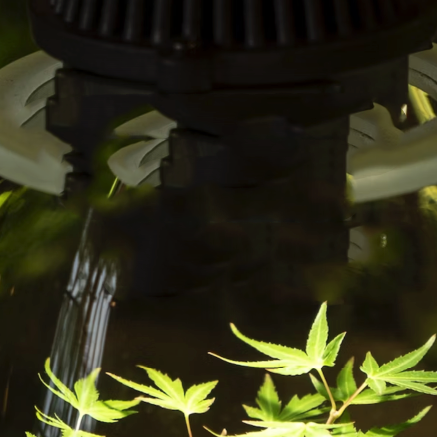DWC - How Much Air Do I Need?
DWC (Deep Water Culture) is a simple but high-yielding type of hydroponics. Another advantage is that because the roots grow directly into the nutrient solution, there is very little medium to dispose of after the grow.
We are often asked how big the air pump needs to be. The answer to that is surprisingly simple - as a rule of thumb, the air pump needs to supply: 1 litre of air per minute for every 4 litres of nutrient solution.
Something to bear in mind is that every metre of air line reduces the airflow rate, but as long as the run is no more than about 2 metres, the rule of thumb above will still be true. If the run is more than 2 metres, then you might need a bigger air pump.
As an example, let's take the IWS Oxypot. It has a reservoir capacity of 19 litres. So, the air pump needs to supply: 19/4 = 4.75 litres per minute.
Some Tips for Growing in DWC
Starting off
When you first put your plants into your DWC system, the roots won't have emerged from the small net pot with clay pebbles in and reached the nutrient solution in the reservoir.
The roots still need water, though. Overcome this by filling the reservoir so that the level submerges the net pot so that what roots you have are partly submerged. Reduce the level of the reservoir as the roots grow until eventually it is just below the bottom of the net pot when roots emerge from the bottom of it.
Keep the pH in the correct range
For DWC, the ideal pH is 5.8, but it definitely needs to stay between 5.5 and 6.5. For best results, check the pH daily with a decent pH tester and adjust it as necessary.
Use a quality hydroponics nutrient
Many growers will already have a favourite nutrient brand. As long as it is a quality hydroponic nutrient, then that's fine.
Monitor the nutrient strength regularly
Ideally, do this daily when you check the pH. If the strength increases over the course of a few days, then it is too strong and ought to be reduced. On the other hand, if it goes down, then it is too weak and ought to be made a little stronger. Most DWC lids are fitted with an inspection hole with a cover on. A bluelab truncheon fits through this hole nicely.
Keep the reservoir topped up
The correct level is a little bit below the bottom of the net pot. If the roots can't find water, then the plant will wilt and die fairly quickly.
Use a quality air pump
They tend to be quieter, which is a bonus if you want to keep your grow quiet and stealthy. Quality air pumps are more reliable too, and that's really important. If the air pump fails, then the nutrient solution will quickly lose its dissolved oxygen. Plant roots need oxygen, so if the pump fails, the plant will suffer and eventually die.
Keep a spare air pump
If you keep a spare air pump and the one you're using fails, then you can change it out quickly. If the failure happens on a Saturday evening, you might not be able to get a replacement until Monday or later. A plant can really suffer or even die in that time.
Prevent "back siphoning"
Back siphoning is where nutrient solution comes up out of the reservoir through the air line and gets into the pump. This will almost certainly cause damage to it. Prevent this by placing the air pump on a surface above the level of the lid of the DWC system. Also, we would advise using a non-return valve (sometimes called a check valve) in the air line. Make sure you fit it the right way around!
Refresh the whole reservoir regularly
Over a week or so, you will probably need to top up the reservoir now and again. Sometimes you might need to do that regularly, particularly during peak flowering. We recommend you change out the entire reservoir once a week if possible. This will help keep deficiencies at bay.
Keep a spare airstone or two
The airflow through airstones can go down over time because of nutrient residues getting trapped in the pores. Also, they tend to become brittle as they get older. It can be handy to have spares, just in case.

